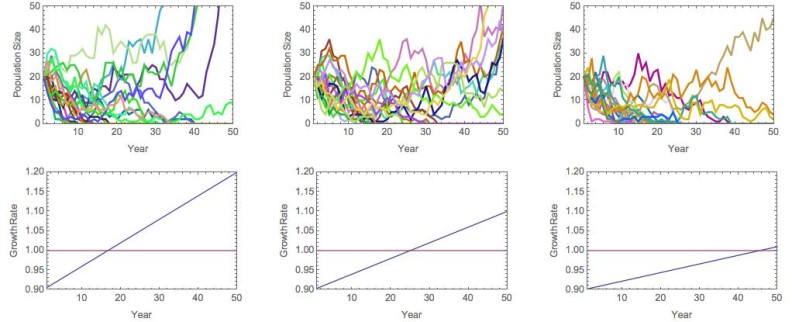investigations: Evo Demo
gomulkiewicz research
The ecological and evolutionary dynamics of populations are driven by both demographic and hereditary processes. Yet ecology and evolution have historically been separate fields of study. Our research addresses a variety of fundamental questions concerned with how demographic and hereditary processes unfold together, particularly in populations threatened with extinction in changing environments.
Selected publications in this research area
- Gomulkiewicz, R., and R.D. Holt. .1995. When does evolution by natural selection prevent extinction? Evolution 49:201-207.
- Holt, R.D., and R. Gomulkiewicz. 1997. How does immigration influence local adaptation? A reexamination of a familiar paradigm. The American Naturalist 149:563-572.
- Holt, R.D., and R. Gomulkiewicz. 1997. The evolution of species’ niches: a population dynamic perspective. Pages 25-50 in H.G. Othmer, F.R. Adler, M.A. Lewis, & J.C. Dalton, eds. Case studies in mathematical modeling – ecology, physiology, and cell biology. Prentice-Hall, New York.
- Secker, J., R. Gomulkiewicz, and M. McPeek, 1998. Interstellar transport and local establishment dynamics of space-borne propagules. In: Proceedings of SPIE: Instruments, Methods, and Missions for Astrobiology. Vol. 3441. R.B. Hoover, ed. pp. 290-300.
- Gomulkiewicz, R., R.D. Holt, and M. Barfield. 1999. The effects of density dependence and immigration on adaptation and niche evolution in a black-hole sink environment. Theoretical Population Biology 55: 283-296.
- Lofaro, T. and R. Gomulkiewicz. 1999. Adaptation versus migration in demographically unstable populations. Journal of Mathematical Biology 38: 571-584.
- Holt, R.D., R. Gomulkiewicz, and M. Barfield. 2003. The phenomenology of niche evolution via quantitative traits in a black-hole sink: A mechanism for punctuated evolution? Proceedings of the Royal Society of London. B 270:215-224.
- Holt, R.D., and R. Gomulkiewicz. 2004. Conservation implications of niche conservatism and evolution in heterogeneous environments. In Evolutionary Conservation Biology, eds. Ferriere R, Dieckmann U & Couvet D, pp. 244-264. Cambridge, UK: Cambridge University Press.
- Holt, R.D., M. Barfield, and R. Gomulkiewicz. 2004. Temporal variation can facilitate niche evolution in harsh sink environments. The American Naturalist 164:187-2004.
- Holt, R. D., M. Barfield, and R. Gomulkiewicz. 2005. Theories of niche conservatism and evolution: could exotic species be potential tests? In Species invasions: insights into ecology, evolution, and biogeography. D. F. Sax, J. J. Stachowicz, and S. D. Gaines (eds.), pp. 259-290. Sunderland, MA: Sinauer Associates.
- Sokurenko, E. V., R. Gomulkiewicz, and D. E. Dykhuizen. 2006. Source-sink dynamics of virulence evolution. Nature Microbiology 4:548-555.
- Gomulkiewicz, R., and D. Houle. 2009. Demographic and Genetic Constraints on Evolution. The American Naturalist 174:E218-E229.
- Gomulkiewicz, R., R. D. Holt, M. Barfield, and S. L. Nuismer. 2010. Genetics, adaptation, and invasion in harsh environments. Evolutionary Applications 3:97-108.
- Barfield, M., R. D. Holt, and R. Gomulkiewicz. 2011. Evolution in stage-structured populations. The American Naturalist 177:397–409. doi: 10.1086/658903.
- Baskett, M.L., and R. Gomulkiewicz. 2011. Introgressive hybridization as a mechanism for species rescue. Theoretical Ecology 4:223–239.
- Kremer, A., G. Bohrer, J. Bridle, S. Gerber, R. Gomulkiewicz, F. Guillaume, E. Klein, A. Kuparinen, R. Nathan, K. Ritland, J. J. Robledo-Arnuncio, O. Ronce, S. Schueler. 2012. Long distance gene flow and adaptation of forest trees to rapid climate change. Ecology Letters 15:378-392.
- Gomulkiewicz, R., and R. G. Shaw. 2013. Evolutionary rescue beyond the models. Philosophical Transactions of the Royal Society B. 368, doi: 10.1098/rstb.2012.0093.
- Gomulkiewicz, R., S.M. Krone, and C.H. Remien. In press. Evolutionary and the duration of a doomed population. Evolutionary Applications. [preprint – pdf 334k]
